09/12/18
K-State Current - September 12, 2018
K-State Current is a weekly news update for the Kansas Board of Regents to apprise the Regents on a few of the many successes and achievements made by K-State faculty, staff and students.
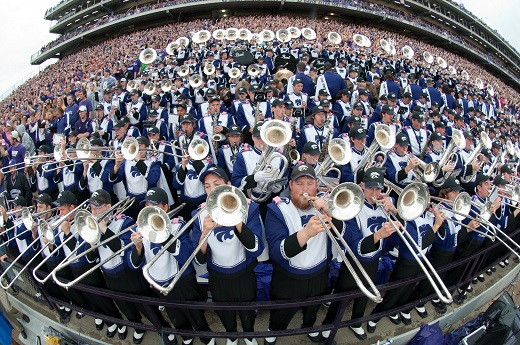
K-State News
Kansas State Polytechnic receives first patent for professor's work on wireless power transfer
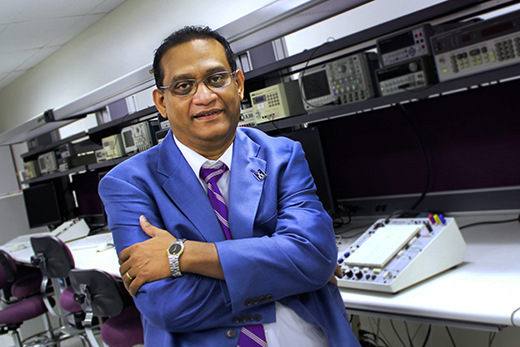 A professor at the Kansas State University Polytechnic Campus has developed a way to improve wireless power transfer, an invention that is giving the campus its first patent.
A professor at the Kansas State University Polytechnic Campus has developed a way to improve wireless power transfer, an invention that is giving the campus its first patent.
Saeed Khan, professor and coordinator of the electronic and computer engineering technology and unmanned aircraft systems design and integration degree options at Kansas State Polytechnic, has been granted a patent for a helical antenna wireless power transfer system by the U.S. Patent and Trademark Office. The purpose of the innovation is to provide a safe and more efficient way of transferring power from one place to another without the use of wires. What makes Khan's work so unique is his discovery of including a ground plane with the system, which increases the amount of power you can transfer at greater distances.
In 2012, Khan began studying wireless power transfer with two staff members at Kansas State Polytechnic after receiving a grant from the Air Force Office of Scientific Research. Their original focus was on powering unmanned aircraft wirelessly; however, as the project evolved, Khan says he saw numerous potential applications of the technology.
"Imagine sitting in a meeting and underneath the conference table is a wireless charging system refreshing your computer's battery, or pulling into the mall and charging your electric car without plugging it in — these are just some of the exciting possibilities of the ingenuity of a helical antenna wireless power transfer system," Khan said.
The system contains two helical, or spiral, antennas tuned to resonate at similar frequencies. Electromagnetic energy is wirelessly transmitted from one antenna to the other in a communication space called the near field, which can be small or large depending on the frequency. By Khan adding a ground plane, usually made from metal material like aluminum or copper, to the system, the distance that the power can be transmitted and the efficiency of the transmission are both increased.
"Being awarded a patent for my research is a recognition of the pure enjoyment I get out of the work I do," Khan said, "but I also think it demonstrates the commitment this campus has to innovation. What students are learning today may not be what they are learning next year, so it is important that we stay involved in creative output for the betterment of our students and our society."
Kansas State University as a whole has a portfolio of more than 275 diverse patents. Christopher Brandt, president and CEO of the Kansas State University Research Foundation, says each of these intellectual discoveries plays a significant role in helping the university meet its land-grant mission as well as reach its goal of becoming one of the nation's Top 50 Public Research Universities by 2025.
"The Kansas State University Research Foundation received 93 invention disclosures in fiscal year 2018; the previous record was 73. We've now seen four straight record years and these are important metrics that demonstrate growth in the research enterprise at K-State," Brandt said. "Technology transfer from the university to the marketplace is also an important part of our land-grant mission. The commercialization of intellectual property developed by K-State accelerates the delivery of research results to the public and shows how our research is closely tied to the economic success of our state."
Interdisciplinary team awarded $2.9 million NSF Research Traineeship grant to strengthen rural communities
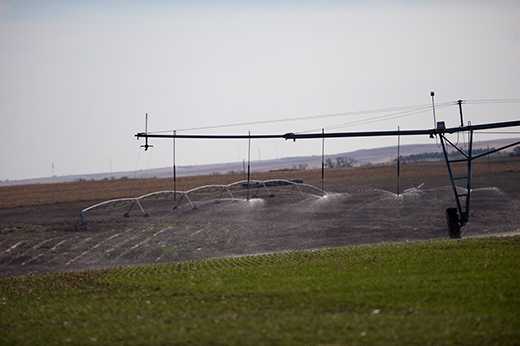 Water shortages and their accompanying threats to the agricultural economy aren't new to Kansas, but a fresh approach to training graduate students at Kansas State University aims to adopt innovations that will protect rural communities.
Water shortages and their accompanying threats to the agricultural economy aren't new to Kansas, but a fresh approach to training graduate students at Kansas State University aims to adopt innovations that will protect rural communities.
Melanie Derby, assistant professor of mechanical and nuclear engineering and Hal and Mary Siegele professor of engineering at Kansas State University, will lead an interdisciplinary team that has been awarded a five-year, $2.9 million National Science Foundation Research Traineeship Program, or NSF NRT, grant to train graduate students who can address these complex challenges. The award was one of 17 NRT projects funded nationwide and is the first NRT awarded in the state of Kansas.
Derby will help meet these challenges by training students to work at the nexus of several disciplines.
"The whole goal of interdisciplinary research is that someone else's perspective makes both your work stronger," Derby said. "We do fundamental engineering work, but we want it to go to the field. We need to know how to make that happen. One of our goals is to help western Kansas and other semi-arid communities to be resilient in the future. We need all the components — engineering, agricultural economics, sociology, and more — to solve these important challenges."
Derby and her colleagues will mentor graduate students as they conduct fundamental research in three areas of the crucial food-energy-water system: conservation of and producer relationships with the Ogallala aquifer, soil-water-microbial systems, and technologies to transform animal waste into energy and water. They also will work to understand engineering, economic and socio-cultural barriers to implementation of emerging innovations.
Building communication skills and a common vocabulary across disciplines is a crucial aspect of the training. Students will engage with policymakers and attend state legislative sessions in Topeka, plus they will spend time at the Southwest Research-Extension Center in Garden City to research smart water technologies and meet with farmers and others whose livelihoods depend on conserving the aquifer and other resources.
Matt Sanderson, co-principal investigator and the Randall C. Hill distinguished professor of sociology, anthropology and social work in the College of Arts and Sciences, said people in many rural Kansas communities are beginning to think of the end of their ways of life.
"They face many problems, from soil erosion, groundwater depletion and water pollution to the loss of population, youth out-migration, growing elderly populations, loss of businesses and declining economic diversity," Sanderson said. "These are not new problems, but the challenge has been how to address them."
Sanderson said that exploring social contexts and helping students think beyond their fields of specialization will encourage new kinds of problem-solving.
"This program holds promise to identify some of the best and brightest new minds and bring them together to work on new ways of seeing, thinking and doing," he said.
"It's an integrated training experience," Derby said. "Students on the engineering side will understand socioeconomics and vice versa."
Charles Taber, Kansas State University provost and executive vice president, said the program Derby and her team have designed is consistent with the land-grant mission of attaining excellence in teaching, research and outreach.
“Sustaining the health of rural communities, the Ogallala aquifer, and the food-energy-water system is mission-critical for Kansas," Taber said. "I look forward to hearing about the achievements of these students as they apply their work and strengthen ties to the communities our university serves."
Carol Shanklin, dean of the Kansas State University Graduate School, said the NRT program helps remove institutional barriers to graduate education and requires graduate students and their mentors to explore complex societal problems from multiple perspectives.
"Top-notch STEM students who participate in this program will receive well-rounded graduate education and develop skills that will prepare them for diverse career opportunities and engage in work that will assist our state and region in addressing the complex problems in the food-energy-water system," Shanklin said.
In addition to Derby and Sanderson, the team includes co-investigators Jonathan Aguilar from biological and agricultural engineering and K-State Research and Extension, Prathap Parameswaran from civil engineering, and David Steward, currently in the civil and environmental engineering department at North Dakota State University; educational lead Gaea Hock from communications and agricultural education; and advisors Nathan Hendricks from agricultural economics, Stacy Hutchinson from biological and agricultural engineering, and Ryan Hansen from chemical engineering. The program will train 50 master's and doctoral students, including 25 funded trainees from the colleges of Engineering, Arts and Sciences, and Agriculture.
Newly funded NSF project seeks to advance our understanding of methane generation
Kansas State University researchers in geology and biology are part of a newly funded National Science Foundation project to research the functions of microorganisms and their role in the production of methane in nature.
Microorganisms are tiny organisms. These days we hear a lot about their impact on our health. The microorganisms that inhabit your gut, for example, help you extract nutrients from your food and defend your body against pathogens. Microorganisms also play big roles in geological environments, where among other things, their reactions can cause minerals to precipitate or dissolve, mobilize hazardous trace elements, metabolize hydrocarbons, and drive cycling of carbon, nitrogen, sulfur, iron, and most other elements in global cycles.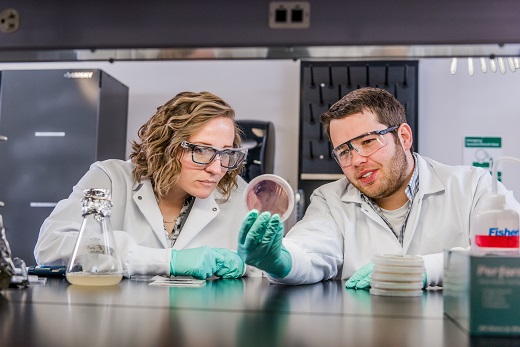
The study, led by Matthew Kirk, associate professor of geology, and Lydia Zeglin, assistant professor of biology, and their collaborator, Qusheng Jin, associate professor of earth sciences at the University of Oregon, is focusing on two microbial reactions in particular: iron reduction and methanogenesis.
Biogenic methane is of interest to science and society because it is an important energy source as well as a potent greenhouse gas. The results of this study can be used to better predict methane generation and manage carbon budgets in systems such as anoxic soils, aquifers, wastewater treatment wetlands, landfills and anaerobic digesters.
In addition, the study also will provide interdisciplinary training to undergraduate and graduate students and increase the involvement of underrepresented groups in science through participation in the Kansas Louis Stokes Alliance for Minority Participation summer research program and summer outreach events for middle school girls. Project personnel also will engage community college students, faculty and staff each spring on recruiting trips that aim to increase awareness of geoscience and geoscience careers among potential transfer students at minority-serving institutions.
To achieve its research goals, the study will use experiments and modeling calculations to create a new model for methanogenesis — one that links competitive and cooperative interactions. The model will improve the ability to predict methane generation and manage carbon budgets in natural and engineered systems including soils, aquifers, landfills, and wastewater treatment systems.
The Division of Biology and geology department are both housed in K-State's College of Arts and Sciences. The NSF awarded $310,748 for the entire project and K-State will receive $196,330 of it.
K-State Faculty Highlight
Biologist awarded $542,060 to study population changes in Kansas birds
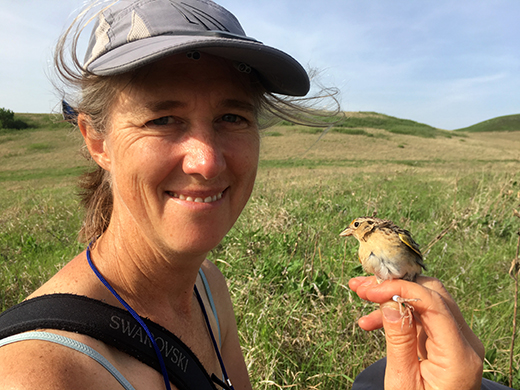 Iconic grassland bird species are in steep decline, and Kansas State University's Alice Boyle wants to know why.
Iconic grassland bird species are in steep decline, and Kansas State University's Alice Boyle wants to know why.
But studying dickcissels, eastern meadowlarks and grasshopper sparrows is complicated by the fact that they move — a lot. And why they move and how that movement affects their populations is not well understood.
The National Science Foundation has awarded Boyle, assistant professor of biology, and co-investigator Trevor Hefley, assistant professor of statistics at Kansas State University, $542,060 for a three-year project to identify the key reasons behind population changes in highly mobile species.
The grassland environment is complex, so understanding dramatic differences in abundance of animals from year to year requires charting differences in and species responses to rainfall variability, grassland management practices such as burning and grazing, and changes in prey and predator communities. Boyle has a head start on gathering those data thanks to the Konza Prairie Biological Station, an 8,600-acre native tallgrass prairie research area jointly owned by Kansas State University and The Nature Conservancy.
"We have four decades of data that have been collected through the Long-Term Ecological Research program at Konza, plus our studies there of individually marked and tracked birds," Boyle said.
Boyle and her team can now link environmental variability — especially precipitation variability — to population biology using both long-term data and detailed studies.
"We can determine the consequences of drought for an individual bird physiologically and their nest success and movement," Boyle said. "This is the holy grail of population biology because you can only do it by pulling all the pieces together. It is incredibly hard to do that in wild bird populations."
Boyle and Hefley's work in developing new statistical methods to integrate and reconcile data and at different spatial and time scales could become a model for other researchers to follow. They aim to cross-train students in both statistical and biological methods and increase appreciation of prairie ecosystems.
"This project builds upon Dr. Boyle's prior research and the long-term datasets collected at Konza Prairie, said John Blair, university distinguished professor of biology and director of the Konza Prairie Biological Station. "Understanding how climate interacts with other environmental factors to affect grassland bird populations will advance conservation efforts at local, regional and global scales. The research approaches developed here by Drs. Boyle and Hefley also can be applied to understand and predict population changes in other species."
In addition to setting a new standard for data integration and application to study of bird populations, Boyle plans to communicate her research to the public using music.
"My first degree was in viola performance, and I'm in a band and play the fiddle," Boyle said. "I want to develop a show that we take to rural Kansas communities talk about the importance of the tallgrass prairie and my experiences as a biologist."
Beth Montelone, senior associate vice president for research, said Boyle's plan is consistent with the land-grant mission to deliver research and education to citizens.
"Professor Boyle's planned musical science outreach and communication activity is a creative way to demonstrate the broader impacts of her research and share it with the public. It is very much in keeping with K-State's goals of conducting cutting-edge research while also excelling in teaching and outreach," she said.
Diane Swanson publishes article on strategy and corporate social performance
Management professor Diane L. Swanson's co-authored paper on how firms' responses to stakeholder pressures create six distinct corporate social performance profiles has been accepted for publication in Long Range Planning, a strategic management journal. 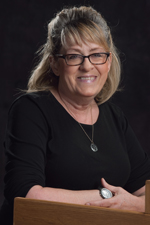
The article, "Managing stakeholder pressures: Toward a typology of corporate social performance profiles," is the result of Swanson's collaboration with business professors from the University of Adelaide and University of South Australia. The paper proposes that a given corporate social performance profile is the result of various stakeholder pressures, which include campaigns for corporate social responsibility, as they interact with a firm's resource endowments, and that these interactions help explain situations in which firms ignore some stakeholders while courting others.
As a practical implication, this understanding can guide managers in their choice and development of socially responsible stakeholder management through a more effective alignment of short-term and long-term strategic goals.
K-State Student News
K-State Weed Science teams claim several top spots at collegiate contest
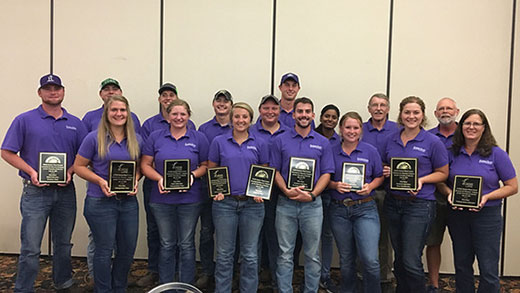 The Kansas State University weed science teams recently had a successful showing, placing first in numerous categories at the regional North Central Weed Science Society/Western Society of Weed Science Collegiate Contest on July 26. The event was co-hosted by the University of Nebraska-Lincoln, North Platte and Monsanto Co., at the Water Utilization Learning Center near Gothenburg, Nebraska.
The Kansas State University weed science teams recently had a successful showing, placing first in numerous categories at the regional North Central Weed Science Society/Western Society of Weed Science Collegiate Contest on July 26. The event was co-hosted by the University of Nebraska-Lincoln, North Platte and Monsanto Co., at the Water Utilization Learning Center near Gothenburg, Nebraska.
K-State competed with two undergraduate teams and one graduate team. All team members are agronomy majors. One of the undergraduate teams took first place among all undergraduate teams competing in the contest. Members of that team and their hometowns included: Keren Duerksen, Newton; Trent Frye, Belleville; Sarah Zerger, Cheney; and Peter Bergkamp, Cheney.
Sarah Zerger placed first overall undergraduate score, farmer problem solving and identification of herbicide symptomology. Keren Duerksen placed second overall undergraduate score and first in weed identification.
This team also placed first in the Undergraduate Team Field Sprayer Calibration event. The other undergraduate team placed third among all undergraduate teams and members were Kaylin Fink, Chapman; Oakley Kauffman, Cheney; Dakota Came, Salina; and Hayden Heigele, Longford.
K-State also had the first place graduate team among teams competing in the Western division of the contest, with the following members: Tyler Meyeres, Vilas, Colorado; Lindsey Gastler, Martinsburg, Missouri; Larry ‘Joey’ Rains, Lone Jack, Missouri; and Luke Chism, Beloit. Chandrima Shyam, Durgapur, India, participated as an individual.
Meyeres placed first overall graduate score and Rains placed third overall graduate score. Individual event winners were Lindsey Gastler, weed identification, and Joey Rains, farmer problem solving event. This team also placed first in Graduate Team Field Sprayer Calibration event.
K-State weed science team coaches were Anita Dille, Kevin Donnelly, and Dallas Peterson.
The contest consists of four events: weed identification, farmer problem solving, written calibration problems and team field sprayer calibration, and identification of herbicide symptomology. Eighty-two students competed from 11 universities across the north central and western regions.